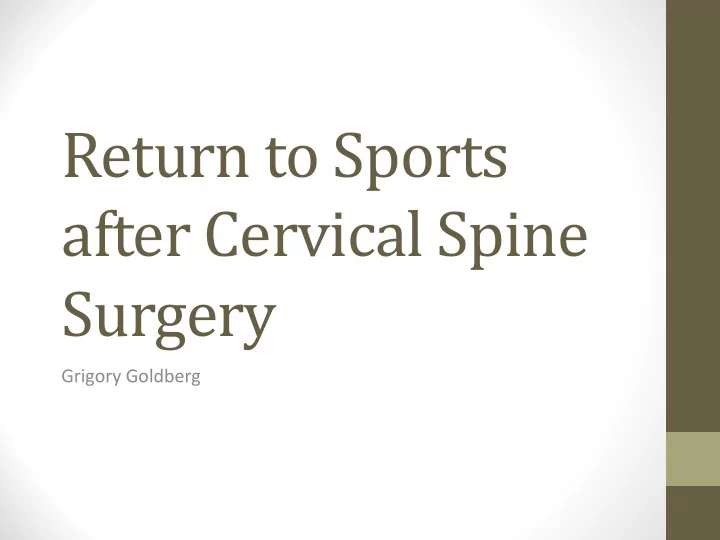

Return to Sports after Cervical Spine Surgery Grigory Goldberg
Cervical Spondylosis in General Population • 10% of general population experience neck pain (1) • Cervical DD has prevalence of 10% at age 30 and 96% by age 80(2) • MRI of asymptomatic pt shows changes in 25% pt younger then 40 and 60% older then 40 (3)
Cervical Spondylosis in Athletes • Retired NFL players age 30-49 have 36.6% cervical arthritis (16.9% age matched controles)(4) • 275 disc herniations from 200-2012 (NFL)(5) Lumbar -74%; Cervical -23% Cervical HNP most lost practice time
Reasons for Surgery persistent severe cervical radiculopathy, • unresponsive to conservative treatment Persistent or worsening weakness or numbness • Progressive myelopathy •
Surgical Options • ACDF (anterior cervical discectomy and fusion) • Cervical foraminotomy • Disc arthroplasty
ACDF • Mechanical changes to the spine • Adjacent segment disease • Very effective and proven procedure
Total Disc Arthroplasty • Preserves movement • Similar outcomes to ACDF • Not suitable for degenerative spines
Cervical Foraminotomy Microsurgical approach • Only suitable for lateral • root compression Avoids altering • mechanics of spine Earlier return to physical • activity Same outcomes with • respect to symptom relief
Literature Review Meredith and etc studied 16 NFL (7) • MRI proved HNP with radiculopathy 3 players required 1 level ACDF – one returned to play 13 players had only non- op tx - eight returned to play 5 non op who did not return 2 retired/ 3 released by the team NFL players can return to play after successful treatment of cervical radic Maroon and colleagues studied 5 football players (8) • All underwent ACDF All returned to play after sx resolution and solid fusion 2 players developed adjacent level HNP that ended career 3 players remained asymptomatic and cont to play Hsu used NFL team injury reports (9) • 99 players with cervical HNP 53 operative and 46 non operative Surgical pts returned to play at higher level
Literature Review • Mai HT studied ACDF vs PF vs TDR (10) 101 professional athletes (NFL, NHL, NBA, MBL) 86 ACDF; 13 PF; 2 TDR (limited number) PF had greater return to play and shortest time return to play Higher reoperation rate at the index level for PF vs ACDF (46.2%vs5.8%) No difference in sports performance between 3 groups • Roberts studied 11 Major League Baseball pitchers (11) 3 non-op tx ; 7 ACDF; 1 TDR 8 players returned to play at average of 11m Surgical pt returned at higher rate then non-op ( 88% vs 33%)
Literature Review • Tempel and etc evaluated 5 NFL players with T2 changes (12) 4 ACDF; 1 non-op tx MRI at 9 months showed complete resolution of T2 changes in 3 pts; partial resolution in 1 pt; and no resolution in 1 pt 3 pts were returned to play no subsequent SCI • Brigham and Capo reviewed 4 players (3 NFL and 1 NBA) (13) MRI documented cervical cord contusion Underwent ACDF All returned to play but 2 developed new contusion No SCI
Return to Play Criteria • It is safe to return to collision and high velocity sports after single level cervical surgery if Solid arthodesis is present at the surgical level Full functional range of motion of the cervical spine No residual neurological deficit Consider post op MRI to confirm decompression and resolution of T2 signal
Thank You 1. Hadler NM. Illness in the workplace: the challenge of musculoskeletal symptoms. J Hand Surg 1985: 10:451-6 2. Lawrence JS, Disc degeneration . Its frequency and relationship to symptoms Ann Rehum Dis 1969 ; 28:121-38 3. Boden SD, McCowin PR, Davis DO, et al. Abnormal magnetic resonance scans of the cervical spine in asymptomatic subjects. J Boen Joint Surg Am 1990; 72:1178-84 4. Wier DR, Jackson JS, Sonnega A, National football league player care foundation study of retired NFL players. Accessed January 15, 2016 5. Mall NA, Buchowski J, Sebala L. Spine and axial skeleton injuries in the National Football League Am J Sports Med 2012 ; 40: 1755-61 6. Triantafillou KM, lauermand W. Degenerative disease of the cervical spine and its relationship to athletes Clin Sports Med 2012; 31: 509-20 7. Meredith DS, Jones KJ, Barnes R. Operative and non operative treatment of cervical disc herniation in National Football League athletes. Am J Sports Med 2013; 41:2054-8 8. Hsu WK. Outcomes following non operative and operative treatment for cervical disc herniation in National Football League athletes Spine 2011; 36: 800-5 9. Maroon JC, El-Kadi H. Cervical neurapraxia in elite athletes: evaluation and surgical treatment J Neurosurg spine 2007; 6: 356-63 10. Mai HT, Chun DS. The difference in clinical outcomes after anterior cervical fusion, disk replacement and foraminotomy in Professional Athletes Clin Spine Surg, 2017, July 17 11. Roberts DW, Roc GJ. Outcomes of cervical and lumbar disk herniations in Major League Baseball pitchers Orthopedics 2011; 34: 602-9 12. Tempel ZJ, Bost JW Significance of T2 Hyperintensity on MRI after cervical cord injury and return to play in Professional athletes. Neurosurgery 2015 77(1): 23-30 13. Brigham CD, Capo J. Cervical spinal cord contusion in professional athletes: a case series with implication for return to play. Spine 2013; 38: 315-23
Recommend
More recommend